Assessment of Airflow Patterns Induced by a Retractable Baffle to Mitigate Heat Stress in a Large-Scale Mechanically Ventilated Barn
Abstract
:1. Introduction
2. Materials and Methods
2.1. Experimental Site and Barn Design
2.2. Experimental Data
2.2.1. Data Measuring Tools
2.2.2. Timeline and Measurement Locations
2.3. Computational Fluid Dynamics Models
3. Results and Discussion
3.1. Field Data Measurements
3.2. CFD Outcomes
3.2.1. Overall Airflow Pattern in a Dairy Barn
3.2.2. Application of the Porous Cow Model
3.3. CFD and Field Measurement Outcomes Comparison
3.3.1. Velocity Profile Comparisons
3.3.2. Overall Velocity Comparisons
4. Conclusions
Author Contributions
Funding
Data Availability Statement
Conflicts of Interest
References
- Polsky, L.; von Keyserlingk, M.A.G. Invited Review: Effects of Heat Stress on Dairy Cattle Welfare. J. Dairy Sci. 2017, 100, 8645–8657. [Google Scholar] [CrossRef] [PubMed]
- Mondaca, M.R.; Choi, C.Y.; Cook, N.B. Understanding Microenvironments Within Tunnel-Ventilated Dairy Cow Freestall Facilities: Examination Using Computational Fluid Dynamics and Experimental Validation. Biosyst. Eng. 2019, 183, 70–84. [Google Scholar] [CrossRef]
- Zhou, B.; Wang, X.; Mondaca, M.R.; Rong, L.; Choi, C.Y. Assessment of Optimal Airflow Baffle Locations and Angles in Mechanically-Ventilated Dairy Houses Using Computational Fluid Dynamics. Comput. Electron. Agric. 2019, 165, 104930. [Google Scholar] [CrossRef]
- Mondaca, M.R.; Cook, N.B. Modeled Construction and Operating Costs of Different Ventilation Systems for Lactating Dairy Cows. J. Dairy Sci. 2019, 102, 896–908. [Google Scholar] [CrossRef]
- Mondaca, M.R. Ventilation Systems for Adult Dairy Cattle: Veterinary Clinics: Food Animal Practices. Vet. Clin. Food Anim. 2019, 35, 139–156. [Google Scholar] [CrossRef] [PubMed]
- Gunn, K.M.; Holly, M.A.; Veith, T.L.; Buda, A.R.; Prasad, R.; Rotz, C.A.; Stoner, A.M.K. Projected Heat Stress Challenges and Abatement Opportunities for U.S. Milk Production. PLoS ONE 2019, 14, e0214665. [Google Scholar] [CrossRef]
- Chung, H.; Li, J.; Kim, Y.; Van Os, J.M.C.; Brounts, S.H.; Choi, C.Y. Using Implantable Biosensors and Wearable Scanners to Monitor Dairy Cattle’s Core Body Temperature in Real-Time. Comput. Electron. Agric. 2020, 174, 105453. [Google Scholar] [CrossRef]
- Harner, J.P.; Smith, J.F. Low-Profile Cross-Ventilated Freestall Facilities—A 2 Year Summary. In Proceedings of the High Plains Dairy Conference, Albuquerque, NM, USA, 22 October 2008; pp. 65–77. Available online: https://www.researchgate.net/profile/Jp-Harner/publication/255549828_Low-Profile_Cross-Ventilated_Freestall_Facilities_-_A_2_Year_Summary/links/53d67d070cf220632f3da3b8/Low-Profile-Cross-Ventilated-Freestall-Facilities-A-2-Year-Summary.pdf (accessed on 23 August 2023).
- Wu, W.; Zhai, J.; Zhang, G.; Nielsen, P.V. Evaluation of Methods for Determining Air Exchange Rate in a Naturally Ventilated Dairy Cattle Building with Large Openings Using Computational Fluid Dynamics (CFD). Atmos. Environ. 2012, 63, 179–188. [Google Scholar] [CrossRef]
- Rojano, F.; Bournet, P.; Hassouna, M.; Robin, P.; Kacira, M.; Choi, C.Y. Assessment Using CFD of the Wind Direction on the Air Discharges Caused by Natural Ventilation of a Poultry House. Environ. Monit. Assess. 2018, 190, 724. [Google Scholar] [CrossRef]
- Rojano, F.; Bournet, P.; Hassouna, M.; Robin, P.; Kacira, M.; Choi, C.Y. Modelling the Impact of Air Discharges Caused by Natural Ventilation in a Poultry House. Biosyst. Eng. 2019, 180, 168–181. [Google Scholar] [CrossRef]
- Tomasello, N.; Valenti, F.; Cascone, G.; Porto, S.M.C. Development of a CFD Model to Simulate Natural Ventilation in a Semi-Open Free-Stall Barn for Dairy Cows. Buildings 2019, 9, 183. [Google Scholar] [CrossRef]
- Mondaca, M.R.; Choi, C.Y. An Evaluation of Simplifying Assumptions in Dairy Cow Computational Fluid Dynamics Models. Trans. ASABE 2016, 59, 1575–1584. [Google Scholar]
- Rojano, F.; Bournet, P.; Hassouna, M.; Robin, P.; Kacira, M.; Choi, C.Y. Modelling Heat and Mass Transfer of a Broiler House Using Computational Fluid Dynamics. Biosyst. Eng. 2015, 136, 25–38. [Google Scholar] [CrossRef]
- Rojano, F.; Bournet, P.; Hassouna, M.; Robin, P.; Kacira, M.; Choi, C.Y. Computational Modelling of Thermal and Humidity Gradients Inside a Naturally Ventilated Poultry House. Biosyst. Eng. 2016, 151, 273–285. [Google Scholar] [CrossRef]
- Drewry, J.L.; Choi, C.Y.; Powell, J.M.; Luck, B.D. Computational Model of Methane and Ammonia Emissions from Dairy Barns: Development and Validation. Comput. Electron. Agric. 2018, 149, 80–89. [Google Scholar] [CrossRef]
- Rong, L.; Nielsen, P.V.; Bjerg, B.; Zhang, G. Summary of Best Guidelines and Validation of CFD Modeling in Livestock Buildings to Ensure Prediction Quality. Comput. Electron. Agric. 2016, 121, 180–190. [Google Scholar] [CrossRef]
- Sørensen, D.N.; Nielsen, P.V. Quality Control of Computational Fluid Dynamics in Indoor Environments. Indoor Air 2003, 13, 2–17. [Google Scholar] [CrossRef] [PubMed]
- Nielsen, P.V. Fifty Years of CFD for Room Air Distribution. Build. Environ. 2015, 91, 78–90. [Google Scholar] [CrossRef]
- Overton, M.W.; Sischo, W.M.; Temple, G.D.; Moore, D.A. Using Time-Lapse Video Photography to Assess Dairy Cattle Lying Behavior in a Free-Stall Barn. J. Dairy Sci. 2002, 85, 2407–2413. [Google Scholar] [CrossRef]
- Bucklin, R.A.; Bray, D.R.; Martin, J.G.; Carlos, L.; Carvalho, V. Environmental Temperatures in Florida Dairy Housing. Trans. ASABE 2009, 25, 727–735. [Google Scholar] [CrossRef]
- Holmes, B.J.; Cook, N.B.; Funk, T.; Graves, R.; Kammel, D.W.; Reinemann, D.J. Dairy Freestall Housing and Equipment; MidWest Plan Service: Ames, IA, USA, 2013. [Google Scholar]
- Menter, F.R. Influence of Freestream Values on k-omega Turbulence Model Predictions. AIAA J. 1992, 30, 1657–1659. [Google Scholar] [CrossRef]
- Wang, X.; Zhang, G.; Choi, C.Y. Effect of Airflow Speed and Direction on Convective Heat Transfer of Standing and Reclining Cows. Biosyst. Eng. 2018, 167, 87–98. [Google Scholar] [CrossRef]
- Sparrow, E.M.; Eichhorn, R.; Gregg, J.L. Combined Forced and Free Convection in a Boundary Layer Flow. Phys. Fluids 1959, 2, 319–328. [Google Scholar] [CrossRef]
- Choi, C.Y.; Kim, S.J. Conjugate Mixed Convection in a Channel: Modified Five Percent Deviation Rule. Int. J. Heat Mass Transf. 1996, 39, 1223–1234. [Google Scholar] [CrossRef]
- Cook, N.B.; Bennett, T.B.; Nordlund, K.V. Effect of Free Stall Surface on Daily Activity Patterns in Dairy Cows with Relevance to Lameness Prevalence. J. Dairy Sci. 2004, 87, 2912–2922. [Google Scholar] [CrossRef]
- Hillman, P.E.; Lee, C.N.; Willard, S.T. Thermoregulatory Responses Associated with Lying and Standing in Heat-Stressed Dairy Cows. Trans. ASABE 2005, 48, 795–801. [Google Scholar] [CrossRef]
- Allen, J.D.; Hall, L.W.; Collier, R.J.; Smith, J.F. Effect of Core Body Temperature, Time of Day, and Climate Conditions on Behavioral Patterns of Lactating Dairy Cows Experiencing Mild to Moderate Heat Stress. J. Dairy Sci. 2015, 98, 118–127. [Google Scholar] [CrossRef]
- Nordlund, K.V.; Strassburg, P.; Bennett, T.B.; Oetzel, G.R.; Cook, N.B. Thermodynamics of Standing and Lying Behavior in Lactating Dairy Cows in Freestall and Parlor Holding Pens during Conditions of Heat Stress. J. Dairy Sci. 2019, 102, 6495–6507. [Google Scholar] [CrossRef]
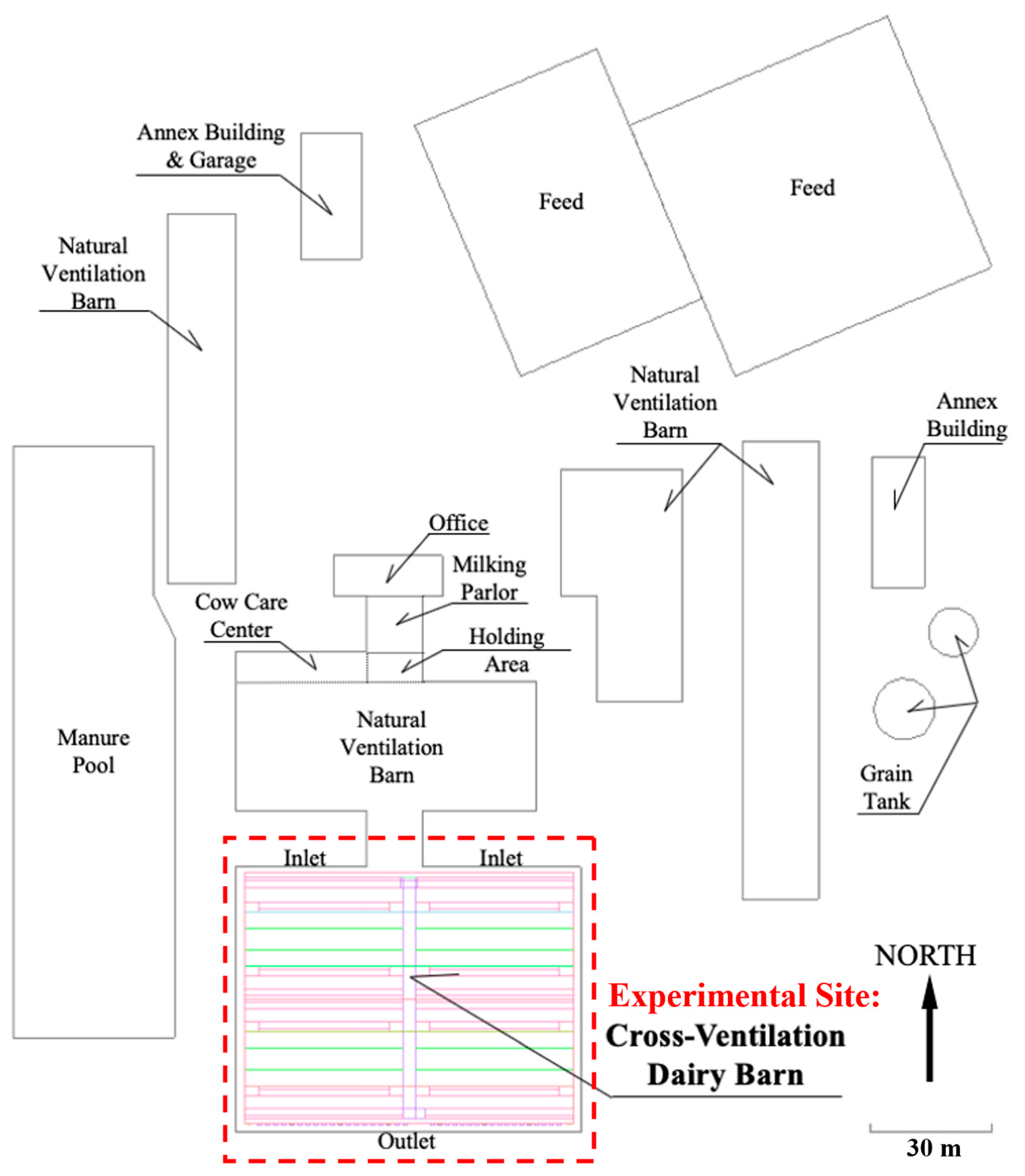
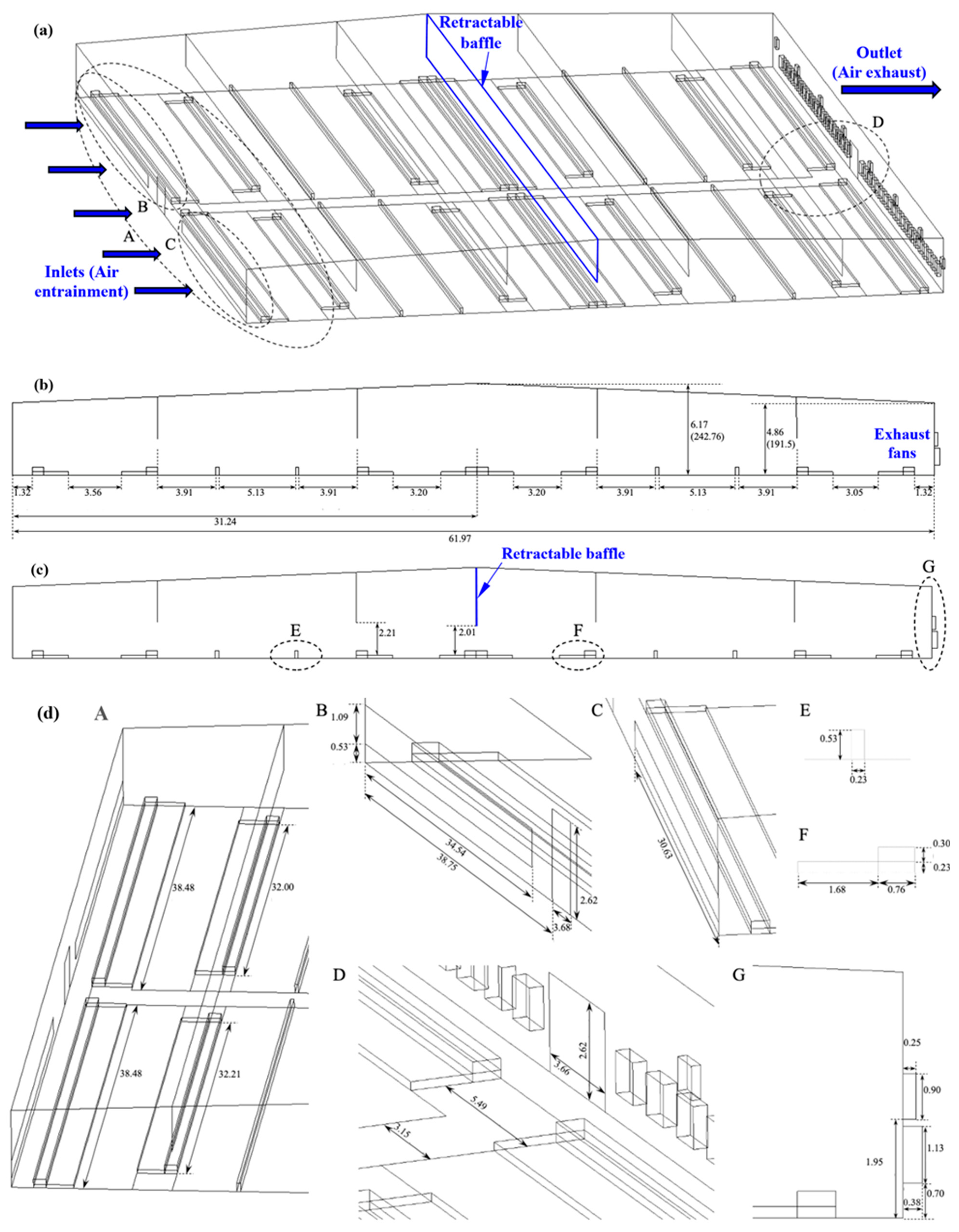
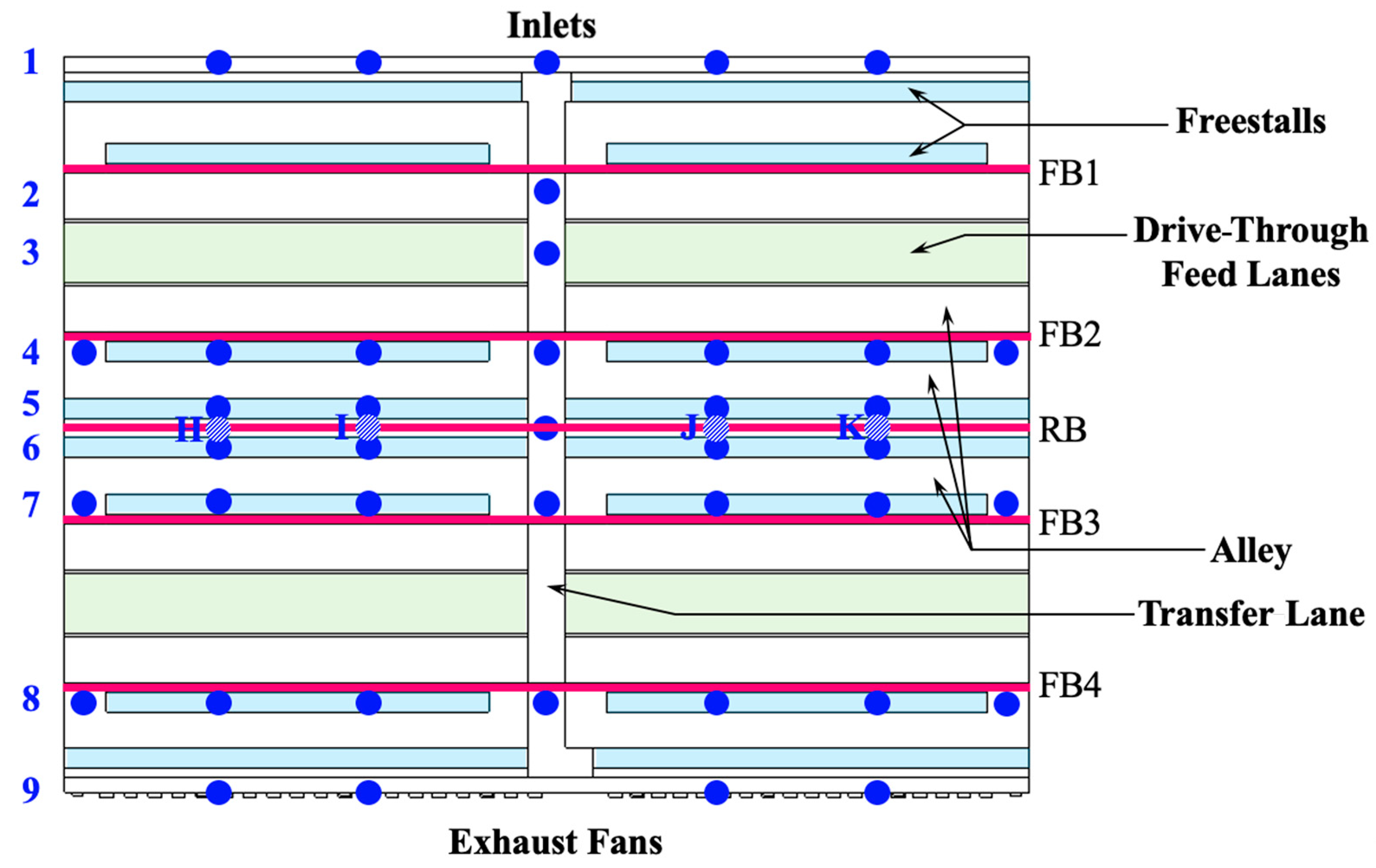

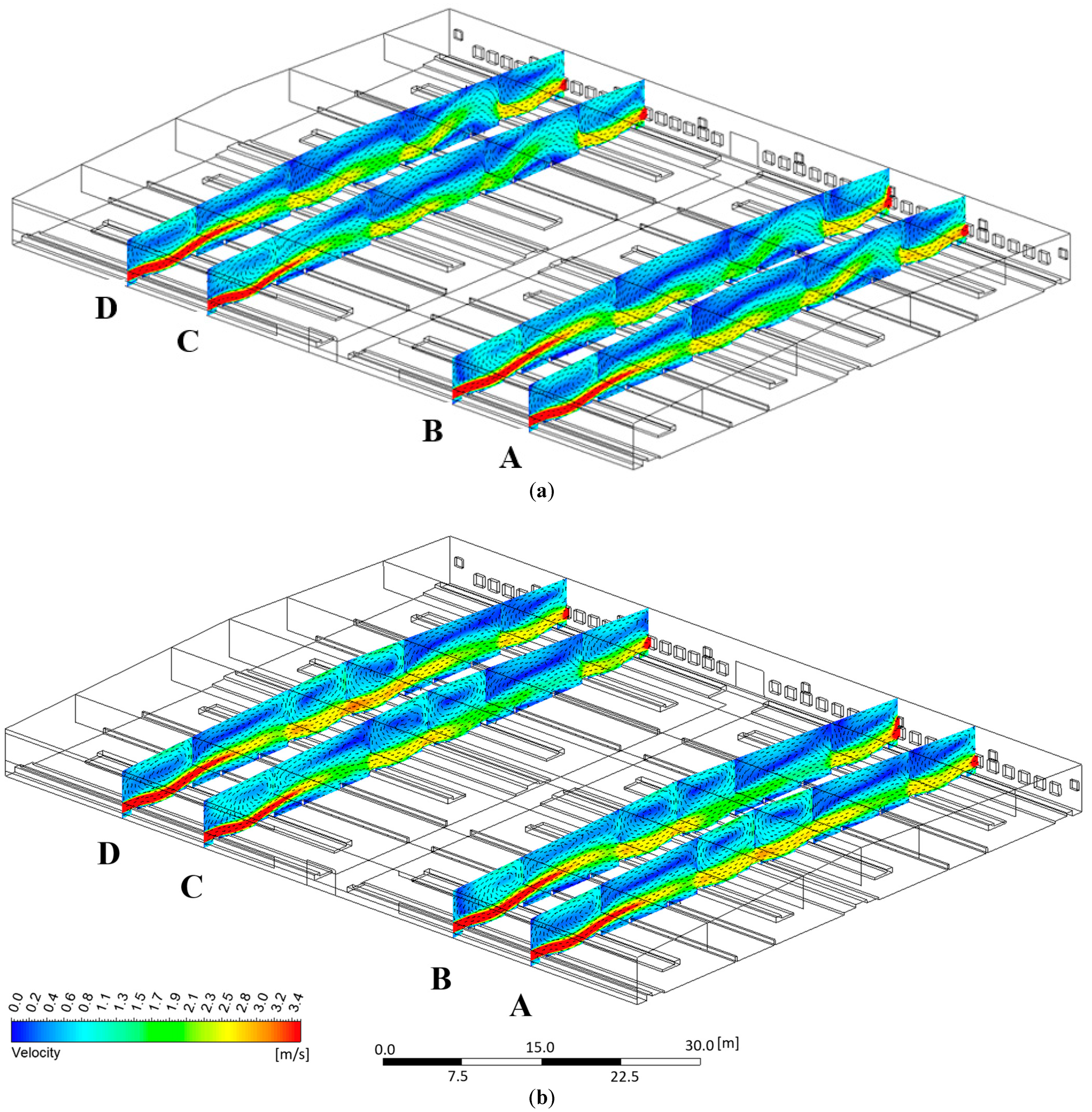
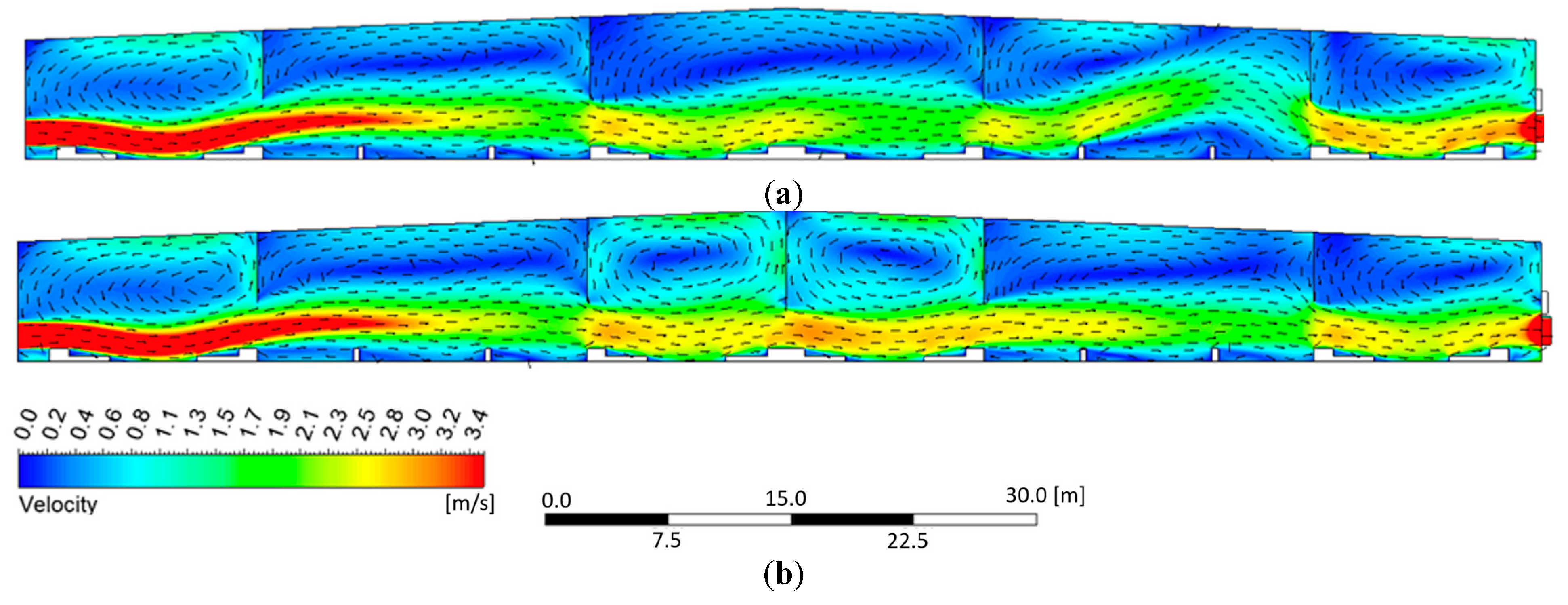
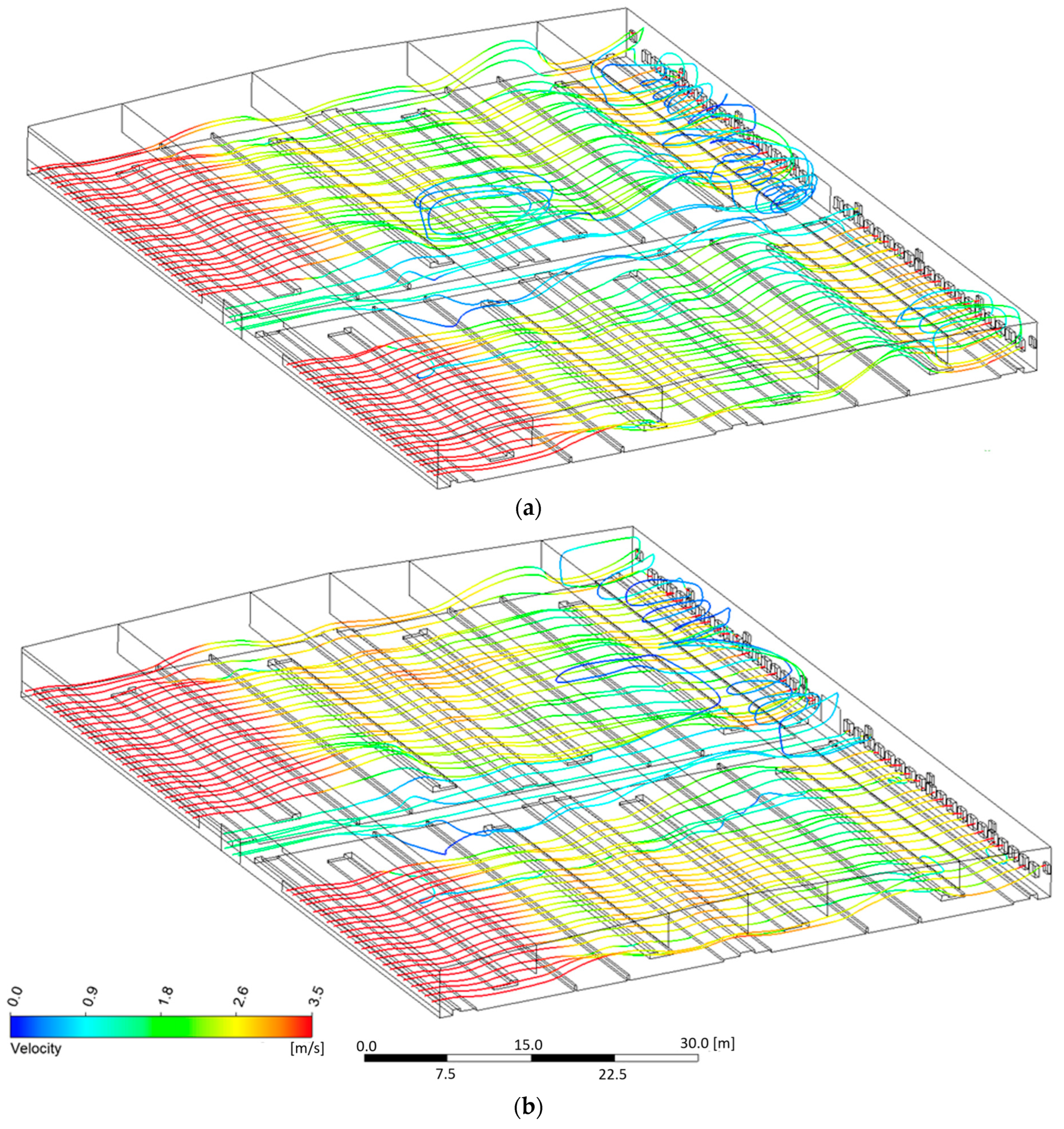
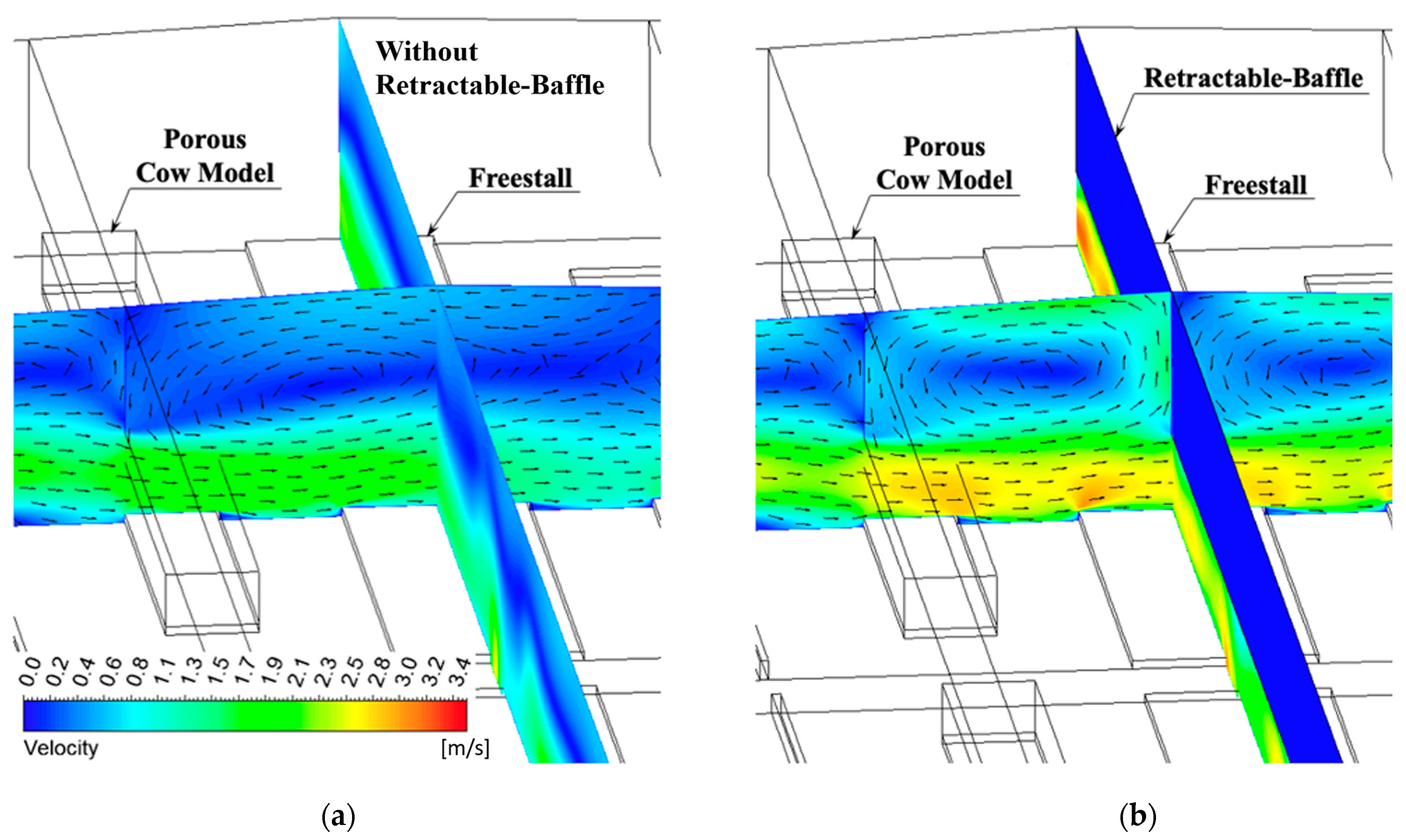
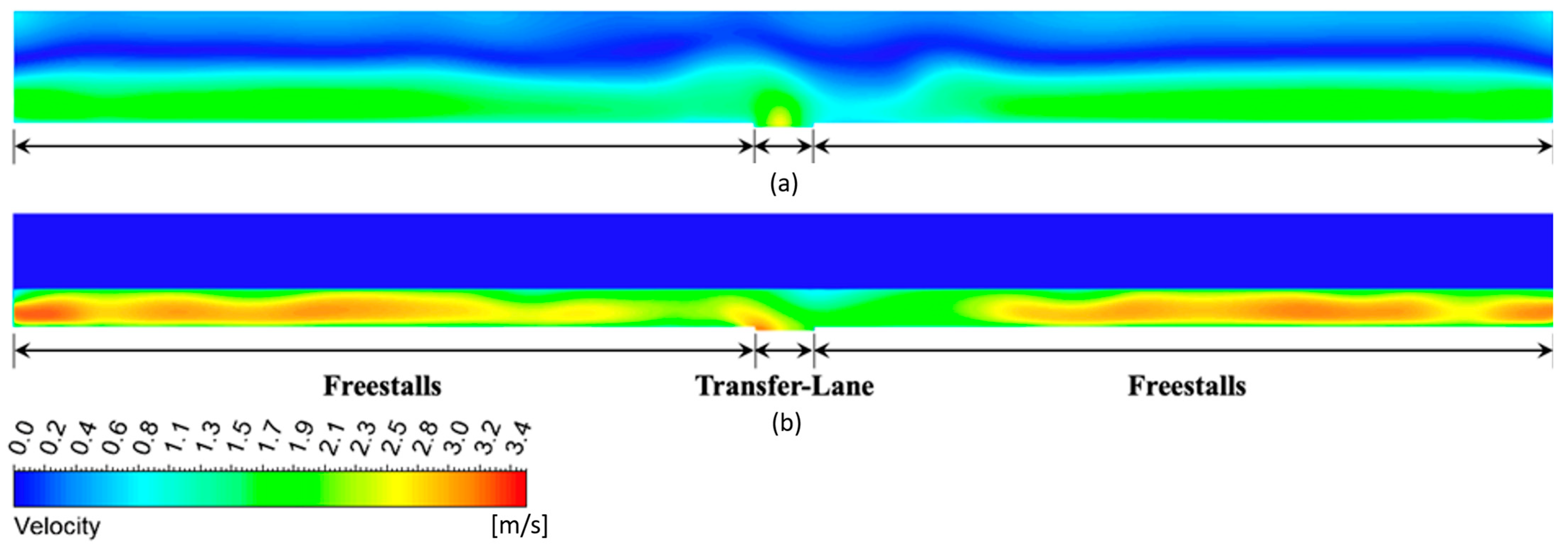
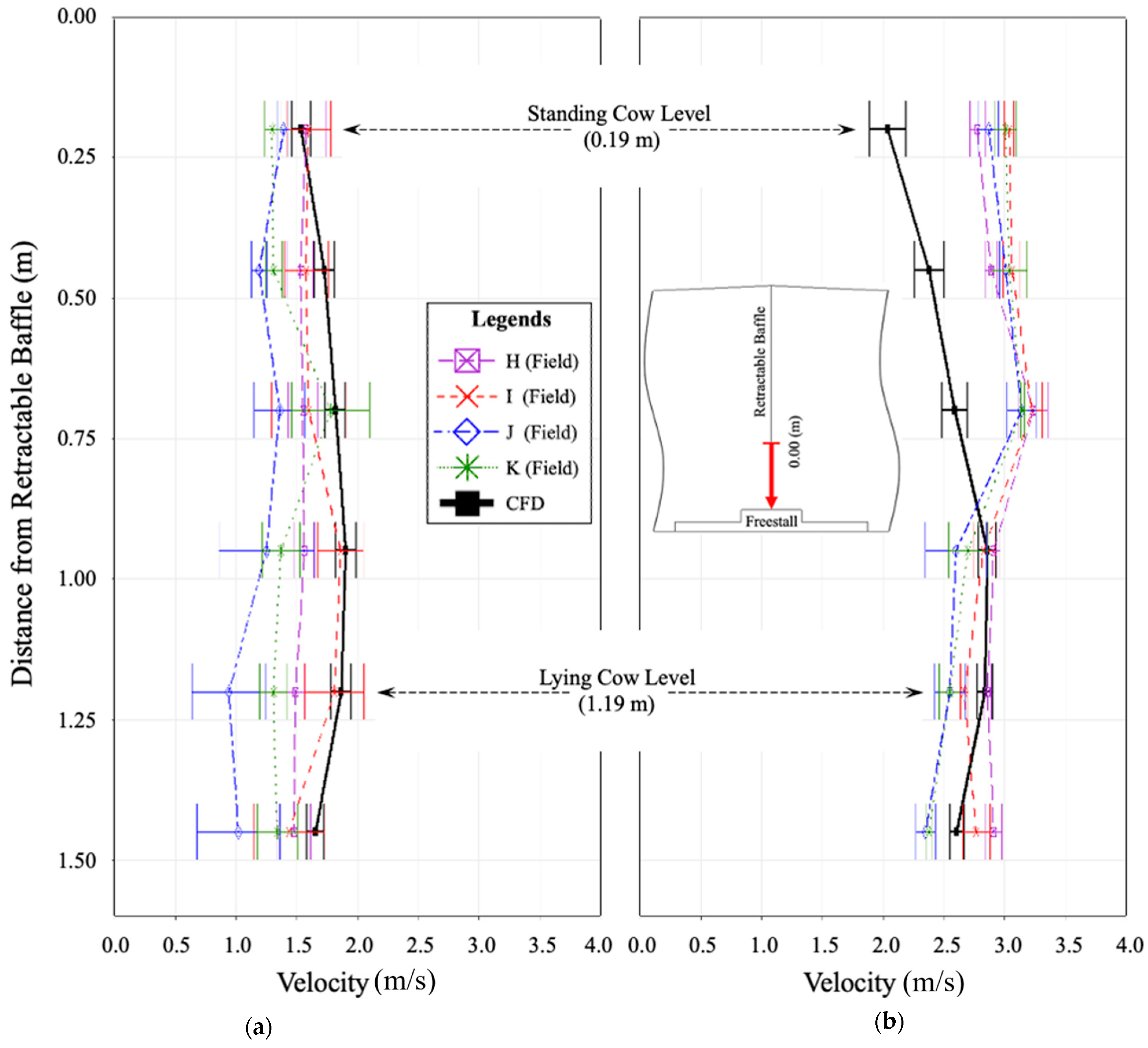
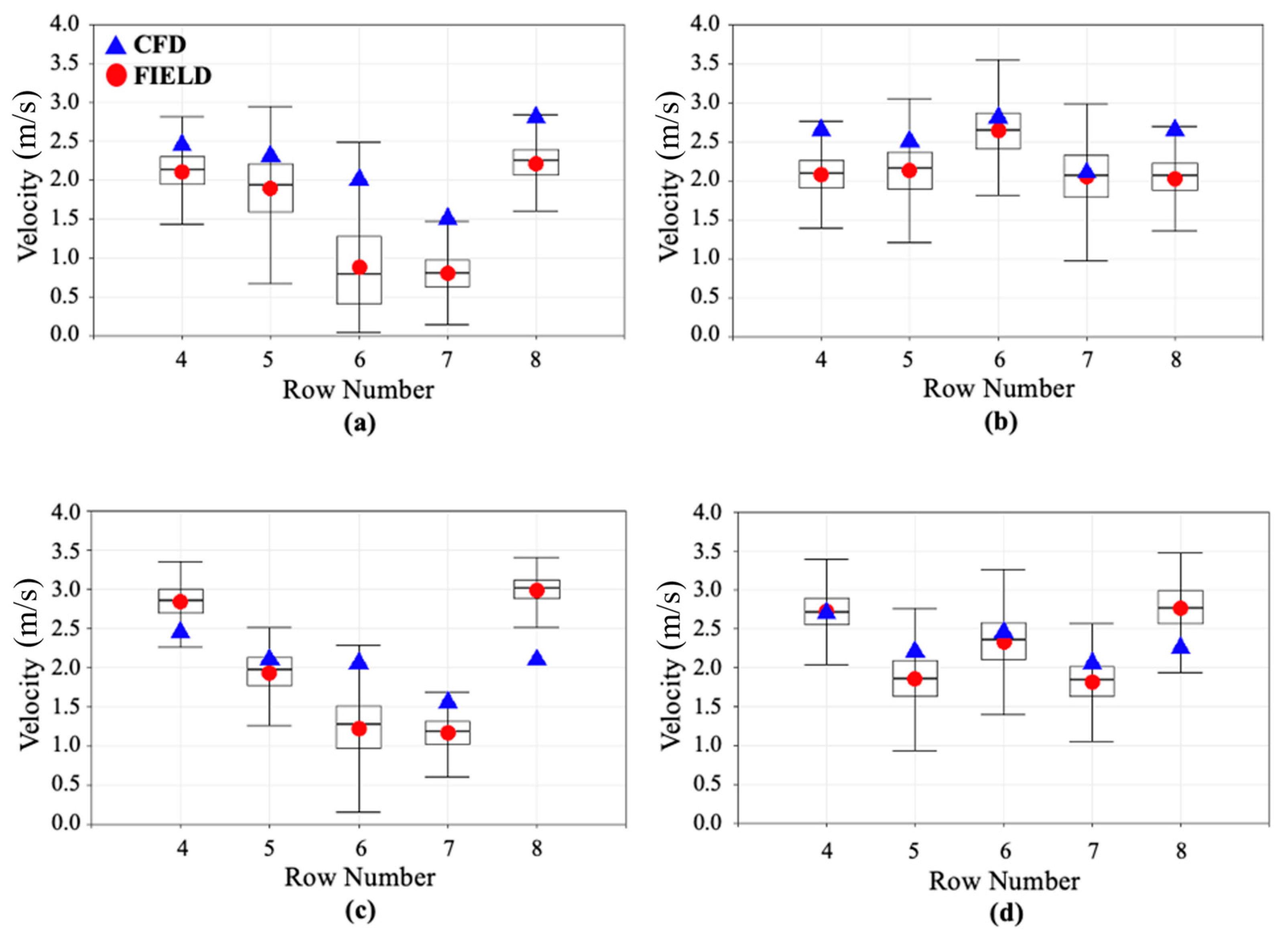
| Locations | Types | Boundary Conditions |
|---|---|---|
| Inlets | Pressure Outlet | Turbulent Intensity: 5% Gauge Pressure: 0 Pascal |
| Transfer Lane Door | Velocity Inlet | 2.77 m/s (without Retractable Baffle) 1.99 m/s (with Retractable Baffle) |
| Outlets (Exhaust Fans) | Velocity Inlet | −4.41 m/s (without Retractable Baffle) −4.15 m/s (with Retractable Baffle) |
| Sidewalls, Ceiling, Floor, Freestalls, and Other surfaces | No slip | Wall |
Disclaimer/Publisher’s Note: The statements, opinions and data contained in all publications are solely those of the individual author(s) and contributor(s) and not of MDPI and/or the editor(s). MDPI and/or the editor(s) disclaim responsibility for any injury to people or property resulting from any ideas, methods, instructions or products referred to in the content. |
© 2023 by the authors. Licensee MDPI, Basel, Switzerland. This article is an open access article distributed under the terms and conditions of the Creative Commons Attribution (CC BY) license (https://creativecommons.org/licenses/by/4.0/).
Share and Cite
Jung, S.; Chung, H.; Choi, C.Y. Assessment of Airflow Patterns Induced by a Retractable Baffle to Mitigate Heat Stress in a Large-Scale Mechanically Ventilated Barn. Agriculture 2023, 13, 1910. https://doi.org/10.3390/agriculture13101910
Jung S, Chung H, Choi CY. Assessment of Airflow Patterns Induced by a Retractable Baffle to Mitigate Heat Stress in a Large-Scale Mechanically Ventilated Barn. Agriculture. 2023; 13(10):1910. https://doi.org/10.3390/agriculture13101910
Chicago/Turabian StyleJung, Seunghyeon, Hanwook Chung, and Christopher Y. Choi. 2023. "Assessment of Airflow Patterns Induced by a Retractable Baffle to Mitigate Heat Stress in a Large-Scale Mechanically Ventilated Barn" Agriculture 13, no. 10: 1910. https://doi.org/10.3390/agriculture13101910
APA StyleJung, S., Chung, H., & Choi, C. Y. (2023). Assessment of Airflow Patterns Induced by a Retractable Baffle to Mitigate Heat Stress in a Large-Scale Mechanically Ventilated Barn. Agriculture, 13(10), 1910. https://doi.org/10.3390/agriculture13101910






